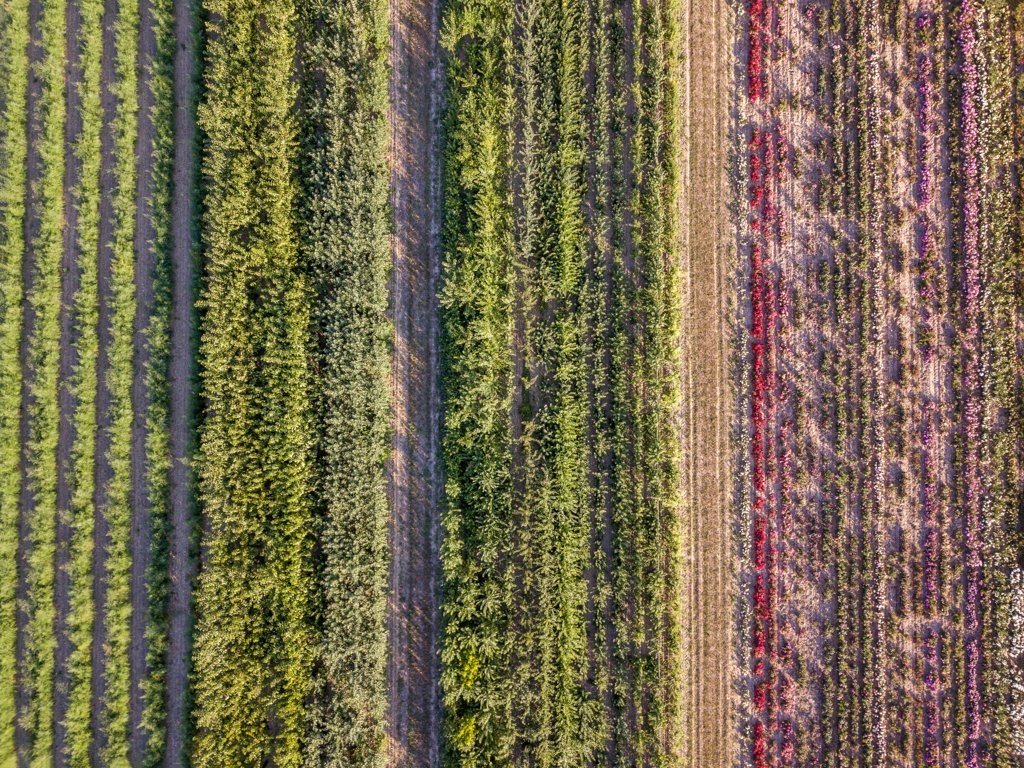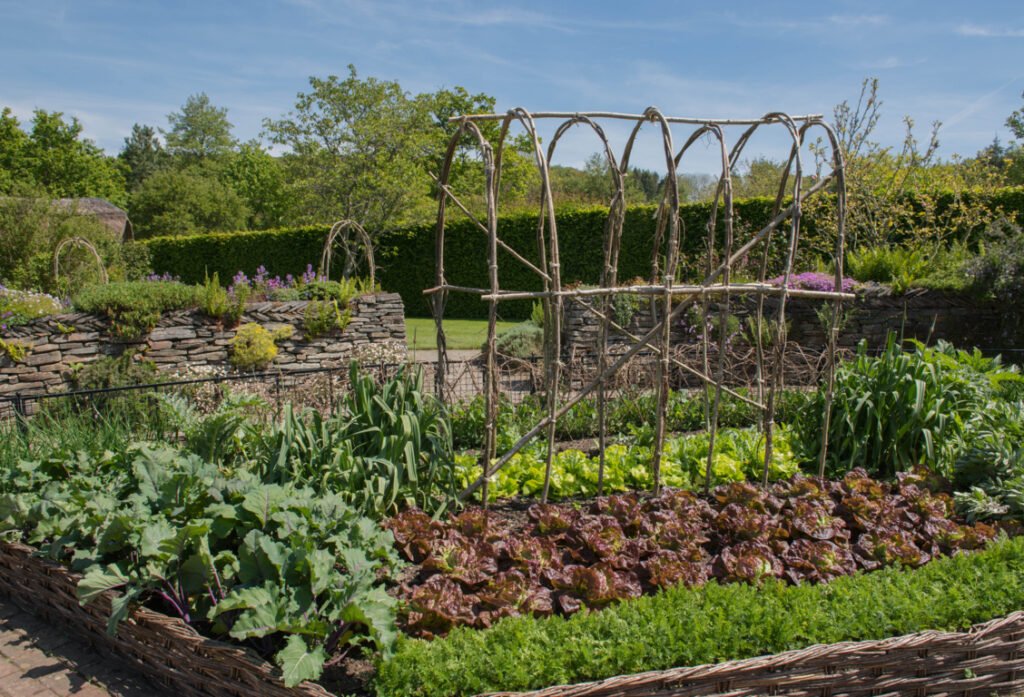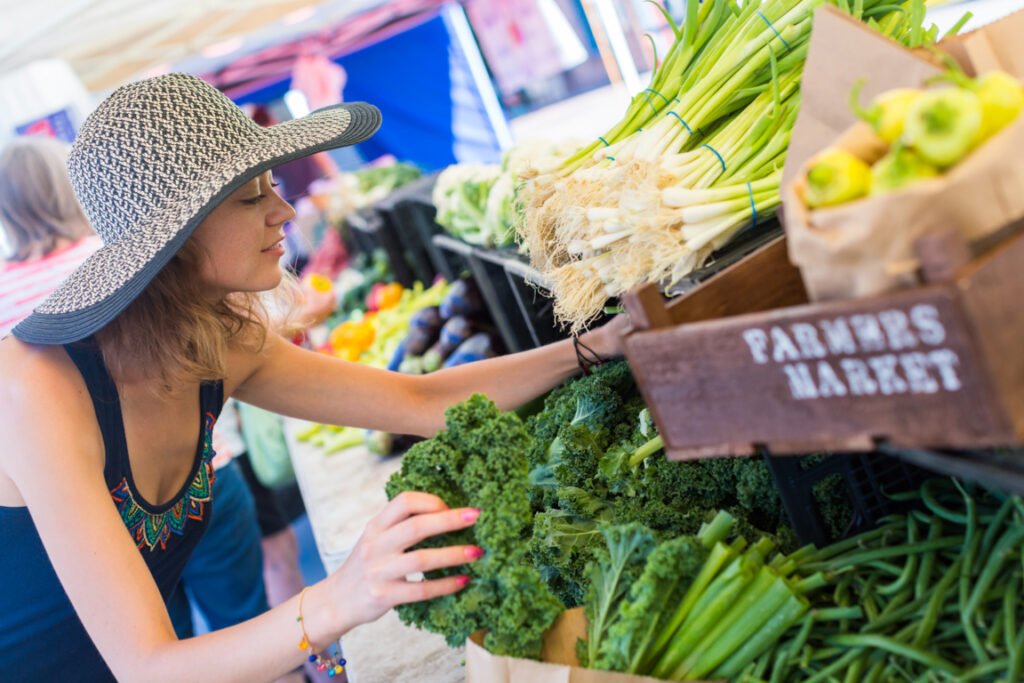
Imagine an organic method of farming that naturally repels diseases and pests, deposits nutrients back into the soil and does not require the input of any chemical fertilizers or pesticides.
Does it sound too good to be true?
Most things usually are, but this is no fairytale farming practice taking place in some fantasyland.
Oftentimes as I wander about my gardens I’m amazed at the amount of interesting, healthy and content forms of life fluttering and buzzing amid the flowers, fruits, vegetables and herbs. What a happy little community it seems. Bees and butterflies carrying pollen, birds turning the soil and helping to sow seeds, squirrels and chipmunks sneaking a berry here and there.
I couldn’t imagine a more complete ecosystem than a garden cultivated with a wide diversity of plants. But what if we zoom out and superimpose these positive effects over a full sized farm?
Polyculture farming is an old concept, ancient really. It was the standard practice up until recent years. Still practiced in developing countries, it has been forcefully forgotten where factory farms have become the accepted norm.
The industrial agricultural complex has no time to ponder about nonsense like the health of the butterflies and bees, or about how interplanting different crops exponentially improves health and production while maximizing space. No, our food industry concerns itself with eradicating with poison any life form that isn’t the intended cash crop and artificially inflating yields with chemical fertilizers.
Polyculture farming addresses, and may be the solution to, all of these issues and more. The traditional practice isn’t exactly practical on a massive scale, but that just reveals the entire approach of the current system is out of whack. Thinking and acting on a small scale is undervalued, yet extremely influential and powerful.
Let’s discuss how polyculture farming harnesses the forces of nature to bring us and our agricultural practices back into harmony with our environment.
What is Polyculture Farming?
As you might deduce by the name (poly- meaning many), polyculture farming intentionally incorporates multiple different plant species within the same growing space. Biodiversity is the most impactful asset a farmer or gardener can utilize.
A wide range of species and varieties, with their own unique cooperative attributes and beneficial traits, planted in close proximity mutually complement each other as though it were meant to be.
It’s a true miracle of nature.
Speaking of nature, many growers describe this practice as imitating the cycles of the natural environment. Native plants and cover crops are implemented not necessarily to reap a specific crop that makes a profit, but because it brings the growing space into a state of equilibrium.
What do you get when you apply the wisdom of nature, then mix it with a good dose of human knowledge, ingenuity and hard work?
That’s right, one comprehensive, healthy and productive farm.
Preventing erosion, replenishing nutrients, loosening the soil, preserving water, acting as a natural mulch and inviting pollinators are just a few of the amazing benefits of polyculture farming.
Read on, because we’ll be touching on these in the next section.

Advantages of Polyculture Farming
The merits of polyculture farming seem too long to list, but we’ll do our best. Here we go!
- Crops that are planted with various other species will have a more complex nutritional profile.
- It is a boon to the microbiome in the soil. Microorganisms and beneficial bugs, like worms, are drawn to soils with broad diversity.
- The land is utilized more efficiently and completely, there is no wasted space.
- Pests and disease are almost nonexistent because they have no way to rapidly spread through such a diverse planting. Some plants release certain compounds that will deter pests that are troublesome to their companion plants. Many native herbs and flowers increase the prevalence of parasitic insects. These predators, like wasps, ladybugs and praying mantis, all prey upon pest species. All of this is achieved without any chemical intervention.
- Pollination levels are vastly improved.
- The amount of soil that is tapped into increases due to the varying root zone depths of different crops.
- Some cover crops are considered “dynamic accumulators”. These special plants, through their natural processes, make available certain nutrients that wouldn’t otherwise be accessible. Comfrey and borage send down deep tap roots, pulling up calcium and other vital minerals to be stored in their leaves. Legumes, such as common field peas, take nitrogen, an essential nutrient for vegetative growth, from the air and fix it back into the soil in an absorbable form for other crops.
- Weeds will be discouraged from entering the growing space and/or smothered by useful cover crops that fill in open spaces.
- Cover crops prevent erosion, retain moisture while feeding and conditioning the soil.
- Diverse plantings are protected against low yields and crop failures. It’s not a major concern if one variety does not perform well.
- In general, many species planted together tend to create a symbiotic environment and complementary community.
Some of the Drawbacks
While no system is perfect, the negative side of polyculture farming is far outweighed by the positive. But to be fair, let’s list out some of the disadvantages of the practice.
- The system will inherently be much more labor intensive. Certain farm equipment and automating tasks may not be an option.
- Supervising and controlling the day to day tasks becomes more complex.
- Understanding the interplay between two or more plants is critical. It can be difficult to juggle the needs of one without affecting others.
- The initial planning, investment and setup of a polyculture system will be more prohibitive than a monoculture.
Polyculture Farming Practices
Polyculture farms implement many tactics to maximize their land and space, all while sustainably replenishing the soil’s nutrients. Here are some of the methods that are used:
- Companion planting is the most prominent principle. Different species and varieties are interplanted because of their unique, mutually beneficial characteristics.
- Cover cropping and green manure are exceptional ways to let the land rest for a season. They hold the cultivated land in place, preventing erosion and soil compaction. The crop is then cut down, left in place and turned into the soil as a fertilizer (green manure), or it can be used as a mulch or animal feed.
- Succession planting is the practice of having a continuous crop growing in one spot. A cabbage crop that is ready in the summer will be immediately replaced with carrots that mature for the fall. No time or space is wasted.
- Crop rotation is important to keep pests and diseases from inhabiting a specific space. Even with a variety of plants intermingled in a plot, it’s still wise to rotate plant families on a yearly basis. Legumes follow nightshade plants, next comes brassicas which are then followed by root crops. From there the cycle restarts.
How is Polyculture Farming Better for Consumers?
Everybody wins when polyculture farming is embraced
The local community especially benefits. In a time of supply chain fragility and food scarcity it is becoming increasingly important to know your neighborhood farmer. Don’t be afraid to introduce yourself and express your appreciation, it goes a long way.
A great way to support local growers is by joining a CSA (community supported agriculture) foodshare. Your initial down payment for the season helps the farmer with season start up costs (of which there are tons) and guarantees you’ll be receiving local, nutrient dense food all season long.
Produce that comes from polyculture farming is inordinately nutritious
And it will be infinitely more nourishing than monocropped, hybrid-GMO frankenfoods.
Organic and sustainable farms are fully aware and pay close attention to the fact that soil health is where it all starts. Our food supply nowadays is mostly void of nutrition because soil has been disrespected, overplanted and depleted. It’s a sad state of affairs.
Grocery shopping at a local farm can be much cheaper than supermarkets.
Especially when shopping for in season produce. Get the delicious fruits and vegetables at their peak of freshness and nutrition. By going directly to the source, there is no shipping cost or energy exhaustion involved in the transaction. You really can save a lot of money in the long run, especially if you’re willing to take a lot of product off their hands and buy in bulk.
Farmers often have a surplus of food and are happy to move a large amount at a discount. Do yourself a favor and stock up on your favorite fruits and veggies. Any extra that you don’t consume fresh can be frozen, fermented, canned or dehydrated, equipping you with a tasty food supply that will last until next season.
Sustainable farms that incorporate a polyculture offer wide selections
Oftentimes you can find obscure, traditional crops that aren’t available elsewhere. Heirloom varieties, nowadays making a huge comeback, are what our ancestors grew and conserved. The colors, flavors, textures and nutrition of these varieties are incomparable to bland, unripe supermarket produce. Liven up the ingredients for your next culinary adventure by honoring some of these heritage breeds.
Polyculture farms are typically smaller in scale
They faithfully serve local communities and their surrounding areas. By patronizing small, sustainable farms you directly inject funds, energy and resources back into a local business.
This is a totally cooperative gesture, as local companies tend to reinvest into their business, creating a web of healthy community based organizations and citizens. As sustainable farms prosper due to their dedication to good practices and quality food, they will inevitably grow.
Larger operations will require a more robust labor force, opening up economic opportunity for folks in the community. The positive chain reaction that is set off is nothing short of incredible and inspiring.
Polyculture farming is the best way to preserve the environment.
A couple of the wonderful byproducts brought to us by industrial farming are that our waterways are now contaminated with toxic runoff and the atmosphere is polluted by poison emissions and exhaust from their machines and factories. Everyday people like you and me, along with the plant and animal kingdoms, suffer these consequences daily.
Polyculture farming contributes to none of this, and in fact, works to reverse these issues. Conditions would immediately improve if the agricultural industry shifted to more sustainable practices.
So never mind shopping at large chain stores, your money will only be lining the pockets of the wealthy. Now is the time to support hardworking, conscientious farmers and support your immediate community.

Sustaining Resources and Regenerative Agriculture
A huge problem in the world today is that consumption has been allowed to run rampant. Polyculture farming does not require excessive energy supplies, the use of destructive machinery or the inordinate intake of fuel and resources. It simply relies on the plants themselves.
The labor force is numerous vegetative varieties that are tasked with the heavy lifting: Tilling, fertilizing and weed control. The need for large amounts of chemically produced fertilizers, pesticides and herbicides is completely eliminated, not to mention the fuel required to ship these poisonous products.
Everything a farm needs is basically produced on site; the exact statement polyculture farmers strive to share with the world.
Cultivating a Fruitful Future
I realize our current condition seems pretty bleak. Corporations are spraying and injecting crops with poisons, while monopolizing and trademarking fruits and vegetables as their intellectual property. It all sounds too dystopian to be true, doesn’t it?
But there is hope after all. The people are waking up to the backwards nature of the massive, monocropped industrial farms. There are ways to feed the world without poisoning them to death first.
And it begins on a micro level.
It can even start in your own backyard.
Every time you plant an heirloom seed or attend the local farmer’s market, you’re chipping away at the armor of the toxic, pollutant-spewing agroindustrial beast.
All these small actions add up to huge results, hopefully in the form of change that sprouts into a more harmonious future that once again incorporates holistic, sustainable agricultural practices.
Why not try your hand at establishing your own polyculture garden? Check out our articles on companion planting to get started!
Frequently Asked Questions (FAQ)
Is polyculture farming organic?
Not necessarily, but most likely. Organic has become a vague term due to official certification status. A farm can be organic without being certified, basing their growing methods on traditional and natural practices without using chemical fertilizers or pesticides. The principles of organic and polyculture farming overlap, therefore the terms are somewhat interchangeable.
Would polyculture farming be more profitable than monoculture?
Monoculture farming is driven solely by mass production and large profits. The business model and scale would determine what is more profitable, but due to the abundance of variety, apparent nutritional content and positive impacts on the environment, we would say polyculture is easily more profitable, especially when considered holistically.
Is polyculture farming a superior method?
Polyculture may involve more planning, knowledge, understanding and labor but it produces higher quality food and treats the environment better. It is the highest standard in farming and is becoming more popular as industrial agriculture conditions worsen.
How is polyculture farming sustainable?
Polyculture farming provides its own fertilizer and pest control by integrating specific plant varieties. Small amounts of energy and fuel are used and the farm produces more than it consumes.



